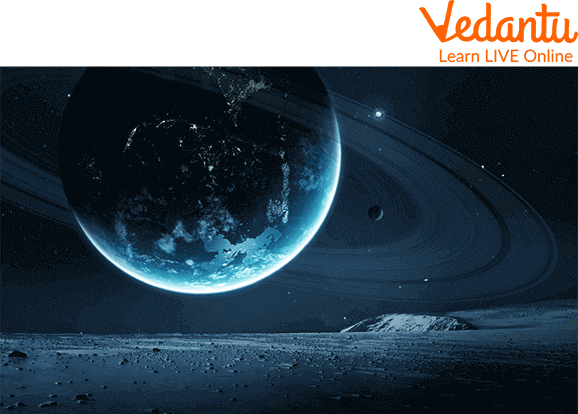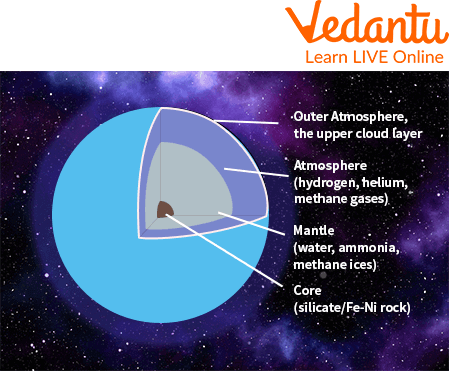




Overview of Uranus
After the invention of the telescope, Uranus became the first planet to be discovered. The planet Uranus was first seen in 1801 by astronomer William Herschel. It was not until 1690, when Isaac Newton discovered Uranus, that it was formally named after the son of Saturn. Though Uranus is one of the large gas planets, it is different because, unlike Jupiter and Saturn, its mass does not concentrate near its core. Instead, it’s spread out over a huge radius of 2434 Earths. It is also the third biggest planet, with a radius of 51,118 km. Now let’s see more about Uranus and some uranus facts for kids.
Physical Features of Uranus
Uranus is the third largest planet within the scheme. It is about 32,000 miles (51,000 kilometres) in diameter or distance through its centre. Uranus is equal to 4 times the diameter of Earth.
Uranus is one of the planets that are referred to as gas giants. It is mostly made up of gases, mainly hydrogen and helium. Tiny amounts of the gas methane offer the planet a blue-green colour. Uranus has no solid surface. Beneath its immense layers of gases, it’s a smaller space of thick, hot liquid.
Narrow rings surround Uranus. These rings appear terribly not like the intense, icy rings of the world Saturn. The rings that surround Uranus are a product of some outstandingly dark material.
Uranus Colour
The colour of Uranus is mainly blue, although it’s a little green due to methane in its atmosphere. This gas is what makes Uranus look green when viewed through a telescope or binoculars.

Uranus
Orbit and Spin
Like all planets, Uranus has 2 sorts of motion: orbit and spin. Uranus orbits, or travels around, the Sun. It takes about eighty-four Earth years to complete one orbit. In simple words, a year on Uranus equals eighty-four Earth years.
Uranus spins concerning its centre in an associate degree uncommon approach. it's tilted in order that it spins nearly on its aspect. Also, Uranus is the one amongst the few planets within the scheme to spin in a clockwise direction. Most of the planets spin in the wrong way. Uranus completes one rotation in about seventeen hours, therefore every day on Uranus lasts about seventeen hours.
Uranus Length of Day
The definition of every day is the quantity of time it takes an associate degree astronomical object to complete one full spin on its axis. On Earth, a day is 23 hours and 56 minutes, but other planets and bodies rotate at different rates. That means future lunar inhabitants will have to get used to a sunlight "day" that lasts for about 14 Earth days and a "night" that lasts about the same time.
Uranus is a weird world in many ways. The most unusual thing about Uranus is that it's tipped over on its side, and "rolls" around the Sun on its side. Meaning one axis or the other is pointed at the Sun throughout a part of its 84-year orbit. The planet will rotate on its axis once every 17 hours and 14 minutes. The Uranus length of day and the length of the Uranian year and the weird axial tilt all mix into a day form every day that is as long as a season on this planet.
Uranus Fun Facts for kids
Moons
More than 25 moons orbit Uranus. The 5 major moons of Uranus are Oberon, Titania, Ariel, Umbriel, and Miranda. They appear to be composed of ice and rock. A number of them have deep valleys and plenty of massive pits referred to as craters.
Observation and Exploration

Information about Uranus
Uranus can’t be seen from Earth without the use of a telescope. Uranus was discovered by astronomer William Herschel using his telescope in 1781. Uranus’ rings were discovered in 1977. The pilotless U.S. orbiter traveller two flew by Uranus in 1986.
Structure And Surface
The structure and surface of Uranus are as follows,
Uranus is encircled by a collection of 13 rings.
Uranus is an associate degree ice giant (instead of a gas giant). It is largely a product of flowing icy materials above a solid core.
Uranus includes a thick atmosphere product of methane, hydrogen, and helium.
Uranus is the sole planet that spins on its surface.
Uranus' Neighbours
Neighbouring celestial bodies of Uranus are as follows
Uranus has 27 known moons.
Uranus is the seventh planet from the Sun. Meaning Saturn and Neptune are Uranus’ neighbouring planets.
Summary
In this article, we learned about Uranus and its physical features. We came to know that Uranus is made of water, methane, and ammonia fluids above a small rocky centre. Its atmosphere is made of hydrogen and helium like Jupiter and Saturn, but it also has methane. The methane makes Uranus blue. We have also learned about the colour of Uranus, what it looks like?, its orbit and spin, and One day on Uranus lasts a little over 17 hours (17 hours and 14 minutes, to be exact).
One year on Uranus is the same as 84 years on Earth. That’s a long time to wait for a birthday cake. We also came to know that more than 25 moons orbit Uranus. Its five major moons are Oberon, Titania, Ariel, Umbriel, and Miranda. They seem to be composed of ice and rock. Some of them have deep valleys and many large pits called craters. We hope you enjoyed reading this article, in case of any other doubts, feel free to ask in the comments.
FAQs on Uranus Facts For Kids
1. Does Uranus have rings?
Uranus has 13 known rings. The inner rings are narrow and dark and the outer rings are brightly coloured.
2. How old is Uranus?
Uranus is about 4.6 billion years old.
3. Does Uranus have land?
As an ice giant, Uranus doesn't have a true surface. The planet is mostly swirling fluids. While a spacecraft would have nowhere to land on Uranus, it wouldn't be able to fly through its atmosphere unscathed either.









